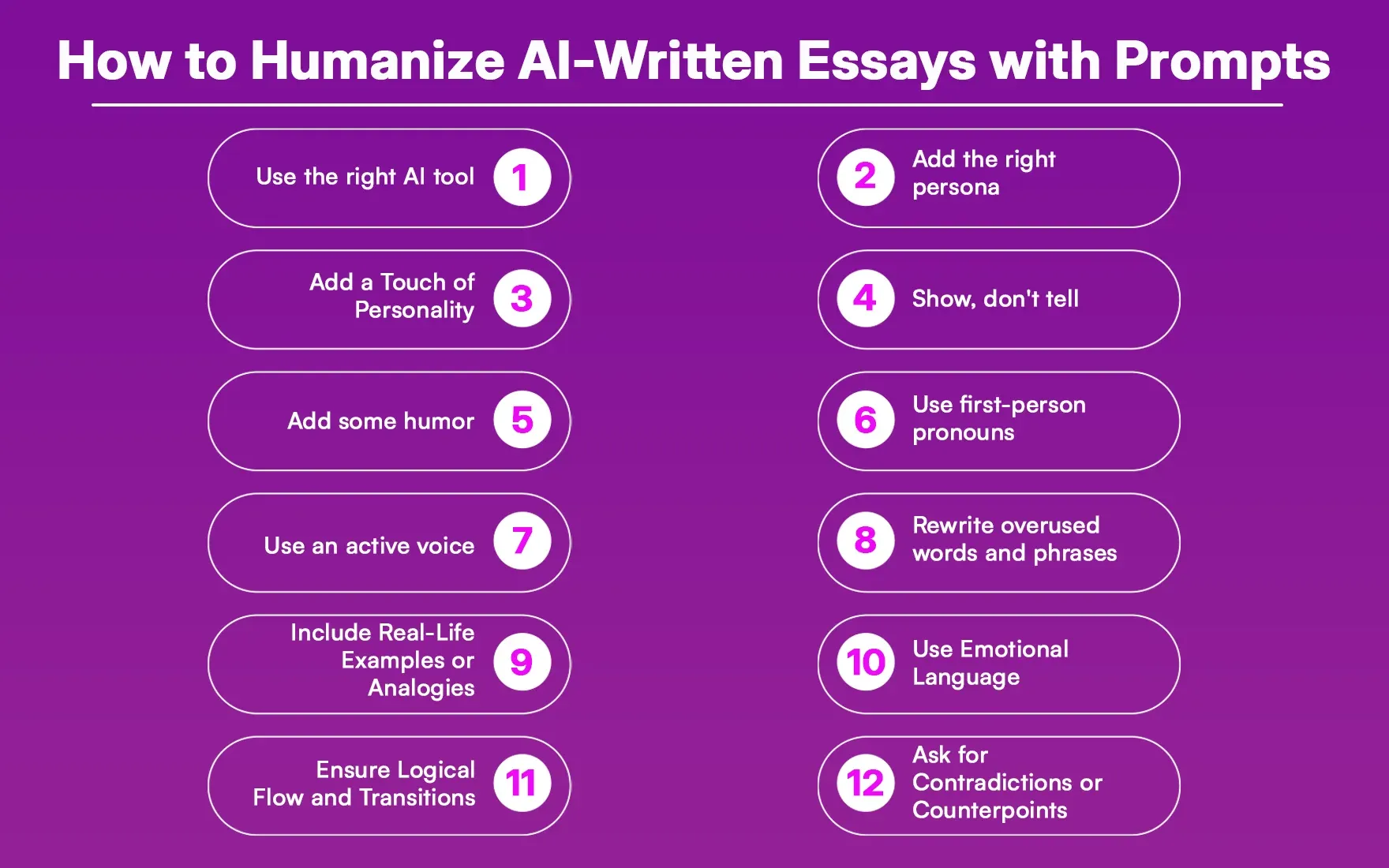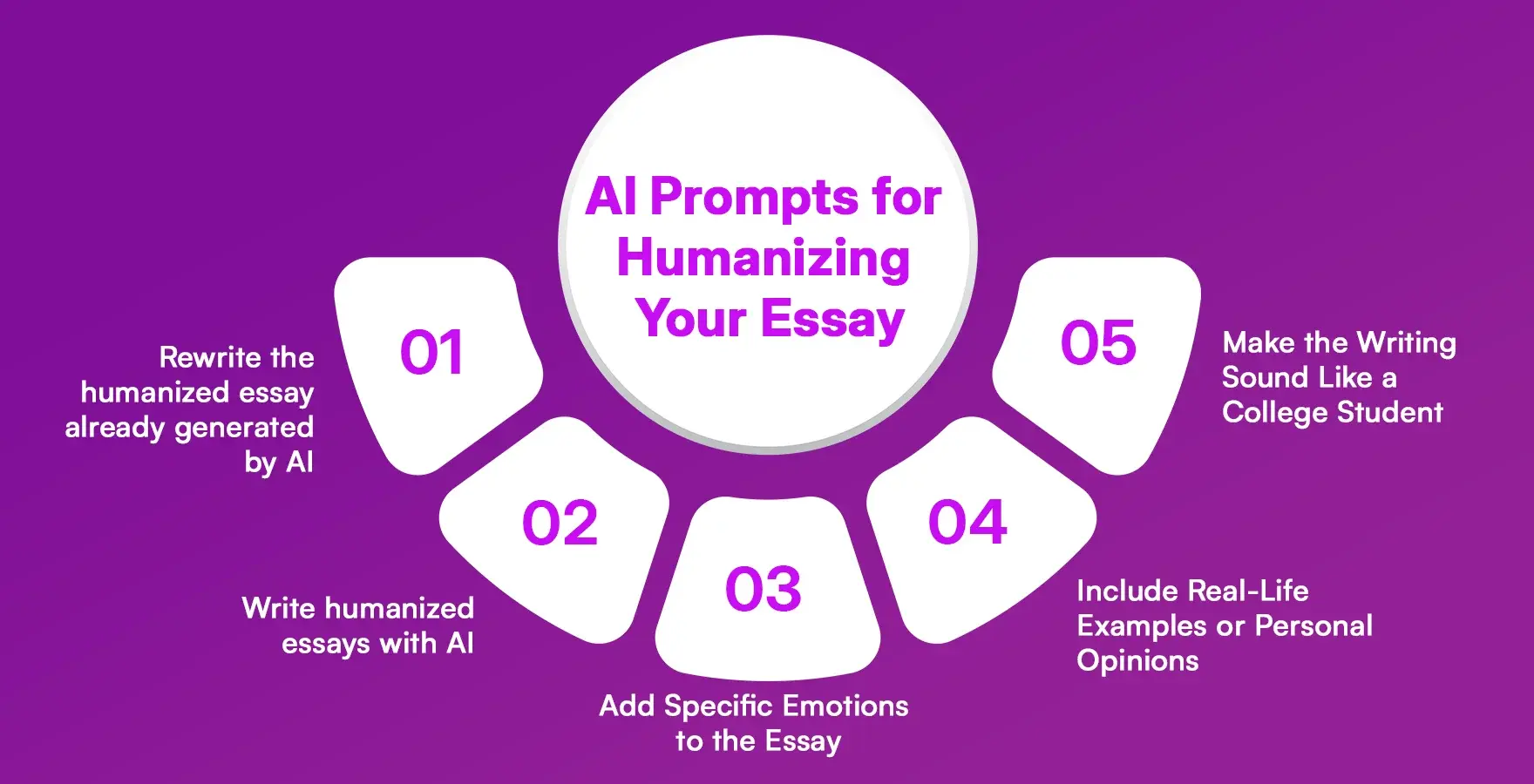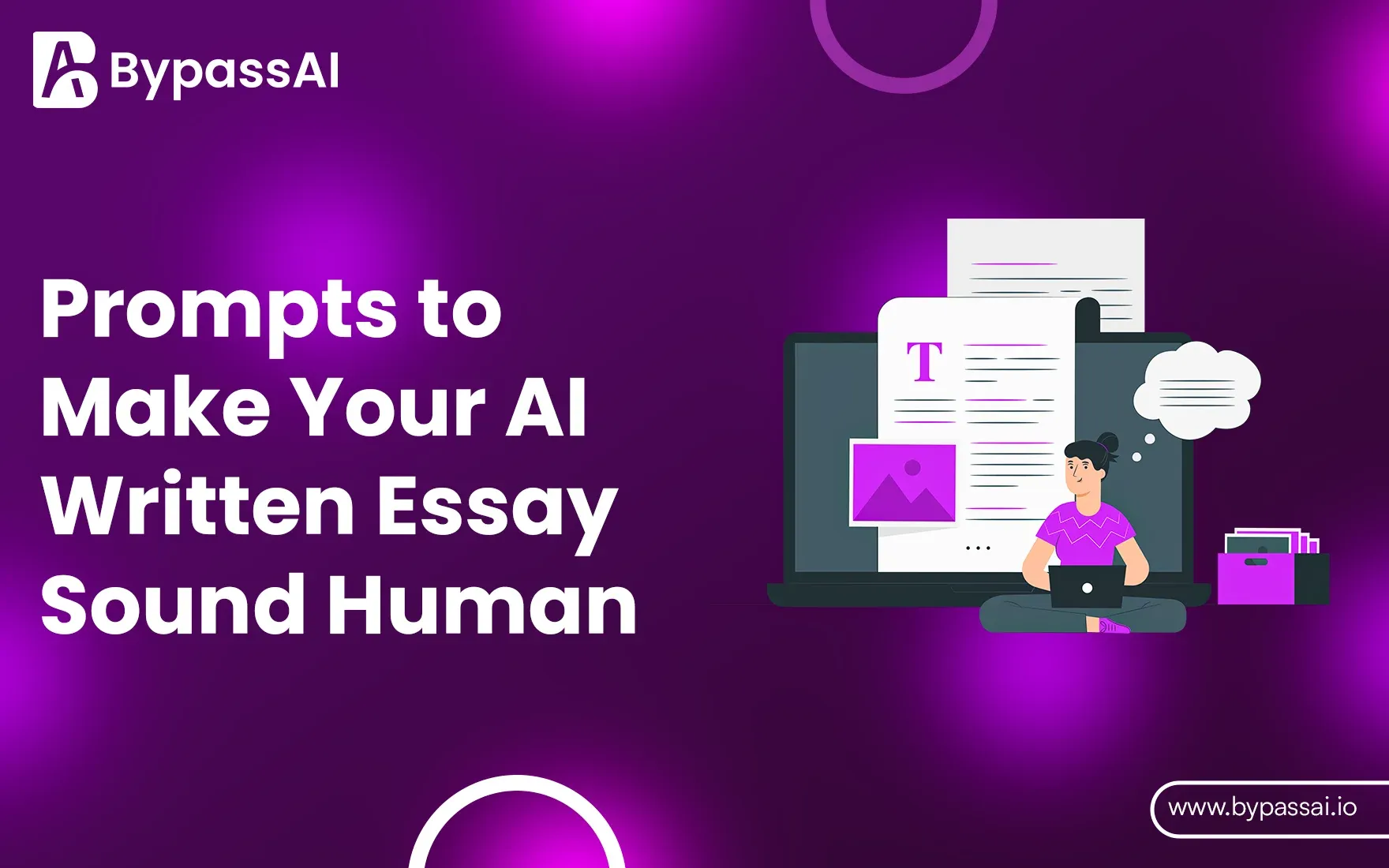Sign In
Welcome to Bypass AI! Sign in to continue your exploration of our platform with all its exciting features.
Forgot Password?
Don’t have an account ? Sign up
Sign Up
Embrace the Future with Bypass AI! Sign up now and let's rewrite the possibilities together.
You have an account ? Sign In
Enter OTP
We’ll send you an OTP on your registered email address
Back to Login
Forgot Password
We'll Send You An Email To Reset Your Password.
Back to Login
Enter OTP
We'll send you an email to reset your password.
Back to Login
Confirm Password
Please enter your new password.
TABLE OF CONTENTS
Quick Summary
Why These Prompts Matter
How to Humanize AI-Written Essays with Prompts
AI Prompts for Humanizing Your Essay
Conclusion
FAQs
In the view of ChatGPT and similar AI writing systems, the novel idea of content creation came into being. The catch here is: an AI-generated essay will often sound robotic, unemotional, and oddly generic. Whether the AI is brainstorming ideas or writing entire essays, there is a question on everyone’s mind: How can one make AI-written content sound more human? This blog is going to offer some practical tips and prompts to make GPT sound more human so that your work feels authentic, engaging, and human-written.
Quick Summary
If your AI-generated essay still feels a bit "silicon," you're not alone, so to speak! The good news is that a handful of clever prompts-sometimes only one-is all it takes to invigorate an essay with the personality, nuance, and narrative flow that human writers give. Consider what proper AI prompts for humanizing your essay would do.
Why These Prompts Matter
Put in emotion and voice: sometimes, switching to first-person pronouns or injecting a little humor can make a prose tweak to make it feel much more lived-in rather than cooked-up in a chemical engineering lab.
Leverage storytelling: Scene-setting and sensory impressions pull a non-human reader towards the experience rather than a lecture.
Additional pacing: Active verbs, chopped sentence lengths, and sneaky transitions keep the subtlety of conversation rather than an act.
Add some real perspective: Cases from everyday life, opinions, and even tiny little contradictions are how real folks really think and write.
Increase credibility and engagement: A genuine human sound goes a long way in gaining readers' trust; they tend to dwell longer on a page, and would actually like to share material.
Save time spent on revision: When the right persona, mood, and structural clues are deliberate from the onset, fewer rounds of manual editing occur later.
How to Humanize AI-Written Essays with Prompts
An AI may be smart, but often, such an AI lacks the richness of experience, emotional range, and storytelling instincts fed into human writers. The solution is to furnish the best prompts possible. Here are the different humanizing treatments and the logic behind them.

1. Choose the Right AI Tool
Choosing the right tool is the foundation. Some AI models are trained for accuracy and short outputs, but they cannot vary tone or develop an idiosyncratic voice. Others are ChatGPT, Claude, and Bypassai.io- allow you to steer the AI with context and tone, perhaps even some emotional intent. In order to create humanlike content, an AI should do much more than just grammar; it should be able to understand storytelling, pacing, and personality.
Why this is correct: A more intelligent model can comprehend your humanizing prompts better and can translate them into content that has life in it rather than being lifeless.
2. Add the Right Persona
When people write, their background, personality, and point of view all influence how they express themselves. AI doesn't have a life experience to draw from-unless you give it one. That is why the assignment of a persona is very important. You may instruct the AI to write as a high school student, a tired single parent, or a passionate climate activist. Suddenly, this persona would have an impact on the tone, vocabulary, and emotional composition.
Why this work: A strong Persona offers your essay a clear voice and perspective, just as real people do when they write.
3. Add a Touch of Personality
The main difference in writing between an AI and a human is the text's "feel." Since humans think, it is natural for human writers to add an opinion or two, maybe a rhetorical question, a joke, or some slang into their writings. An element of this almost always gives the impression to the reader that there is a real person speaking to them. Such is from an AI perspective--an AI WILL NOT add opinion or casual jokes such as this unless you ask for it in your prompt. Hence, one reason to write your prompt in a way that invites the AI to insert casual language, opinions, or sarcastic humour.
Why this works: The personality injected makes the audience connect with the piece better and improves readability.
4. Show, Don't Tell
AI likes to tell readers exactly what is happening—"Climate change is dangerous" or "Exercise is important." Great writing paints a picture. Instead of saying "Exercise is good," a human writer might describe the thrill of finishing a 5K run for the first time: the heart pounding, the eyes glistening with joy. Asking AI for descriptive scenes, metaphors, or anecdotes can achieve this result.
Why this works: Vivid imagery allows readers to pick up what the text is communicating and even feel it, which robotic summarization will never be able to do.
5. Add Some Humour
One of the easiest ways to humanize writing is humour. There is a personality, timing, and emotional intelligence-AI writing stellar to the wane in those things! Even light humour, ironic comparison or a roast of sorts- again transforms writing into a pleasure to consume. Neither crowning achievement in stand-up comedy nor contrived anecdotes involve it is merely a couple of rare instances that keep the reader amused or satisfy him.
Why this works: Humour creates trust and connection with the reader. It also breaks the monotony of serious or mechanical writing.
6. Use First-Person Pronouns
Writing in the first person, with phrases like "I," "me," or "we," immediately lends personality to a piece. This style gives the sense of someone reflecting upon their thoughts rather than someone delivering information. By default, AI systems tend to proceed in the third person or use a neutral tone-unless directed otherwise. Giving the AI instructions to write in the first person transforms the essay into a discussion rather than a textbook.
Why this works: A personal pronoun builds a sense of intimacy with the audience and makes your work sound as though it came from an actual human being expressing personal opinions.
Also read this article : How to Make AI Content Undetectable
7. Use an Active Voice
Another common error AI commits is transitioning into passive voice, where the subject of the sentence becomes obscured or vague (e.g., "The mistake was made"). Human writers prefer active voice (e.g., "I made a mistake") since it is clearer and more direct. By ensuring that the agent uses the active voice, the sight of males is half the world away from the confidence and the energy in your writing.
Why it works: Active voice drives the sentence forward, improves clarity, and sounds assertive and living.
8. Rewrite Overused Words and Phrases
AI runs after clichés and filler phrases, such as “in conclusion,” “it is widely known,” or “throughout history.” These make your writing weaker and, understandably, programmers tell when it is a machine writing. The same is true for telling AI to avoid or just rewrite such common phrases so that your writing can appear fresh and human.
Why this works: Out-of-the-box phrases catch the eye and draw personality into the writing. Avoidance of repetitive language gives the writing validity.
9. Include Real-Life Examples or Analogies
This is how human writers explain complicated ideas by means of examples or comparisons. Think of the economy as an example of manipulation of the household budget, or one person may explain anxiety by telling a story about a friend. The AI may be generating an analogy only when prompted. Analogies, anecdotes, and personal stories make things more interesting and easier to capture.
Why this works: Readers relate to concrete accounts and situations rather than abstract theories or statistics.
10. Use Emotional Language
AI writing has almost no room for emotion-neither neutral, fact-based, nor dry. Much of the human world reads to FEEL. Words imbued with emotions, such as "frustrated," "excited," "overwhelmed," or "hopeful," create an empathic bridge between the writer and reader. Hence, when you ask an AI to encompass the use of emotional words, it deepens the whole essay.
Why this works: Emotion creates force and remembrance in writing. It changes mere information into human experiences.
11. Ensure Logical Flow and Transitions
Sometimes AI content feels choppy or disjointed. Some paragraphs feel like separate blog posts that have been crudely stitched together. Human writers instinctively employ transitions, such as "However," "On the other hand," or "Next," to steer readers through their narrative. You can also include such instructions for an AI."
Why this works: These smooth transitions help the reader to follow your argument with ease; this makes the writing more coherent and convincing.
12. Ask for Contradictions or Counterpoints
Human writers don't simply set forth their own opinion; most do argue the other side. They acknowledge that it is complicated, listing the pros and cons, or considering that critics might say something. Most AI-generated essays do not do this on their own and must be specifically told to. The addition of counterpoints or contradictions makes your essay appear more considered and balanced.
Why it works: Recognizing complexity gives an impression of depth, maturity, and honesty, elements original to human writing.
AI Prompts for Humanizing Your Essay
Once you have decided that your AI-generated essay needs humanization, the first thing to do is to set the right prompts. Prompts, in the broadest sense, may be thought of as specific prescriptive instructions that change how the tone, rhythm, or character of the writing is perceived, and thus, from being dry and generic, into something warm, considerate, and fully readable.
Here is an outline of the best prompts based on purpose to help you get ChatGPT to write like a human.

1. Rewrite the Humanized Essay Already Generated by AI
Prompt example
“An essay written by artificial intelligence needs to be converted into human language, having a casual vibe and free-flowing thought line.”
Meaning
This prompt is fit when an AI draft of an essay sounds stiff, robotic, or too formal. Instead of having the AI re-generate a new essay, you have it act as an editor and rewrite the essay in a far more relatable manner.
Why it works
Gives another pass with a better tone, rhythm, and structure, while the original idea remains intact. It changes rigid or clichéd diction into fluid and humanized phrasing.
Best For
- Final polish
- Converting robotic drafts into readable prose
- Keeping the structure but changing the voice
2. Write Humanized Essays with AI
Prompt Example
“Write a 1,000-word essay on climate change in a natural, human tone, as if written by a concerned university student.”
What does it mean
This prompt demands that the AI generate the essay from scratch-but with a clear, humanlike tone. You are not just asking it to inform; you want it to connect.
Why it works
The tone ("natural," "human"), emotion ("concerned"), and personality ("university student") set in the prompt guide the AI's word choice, phrasing, and examples that one in that position would use.
Best for
- Full-length blog posts or essays
- Tone-guided writing
- Essays with personality and storytelling built in from the beginning
3. Add Specific Emotions to the Essay
Prompt Examples
"Turn this paragraph into one that speaks of frustration and also empathy for students in the throes of student loan debt." "Make the conclusion hopeful and inspiring."
What does it mean
A paragraph sometimes gets its point across clearly, but emotionally remains flat. The prompt asks the AI to impart a specific feeling-anger, joy, fear, hope, etc. in your text.
Why it works
AI is cold without any clues to go by. While giving it an emotional word, you are teaching it about the mood the language has to convey.
Best for
- Persuasive or reflective essays
- Editorials or opinion articles
- Emotional hooks and powerful endings
4. Include Real-Life Examples or Personal Opinions
Prompt Example
Give a personal anecdote or everyday example that explains this idea.
What does it mean
The user is asking that the AI take abstract ideas and put them into everyday situations with which people can relate—that is, procrastination affecting students or budgeting affecting families.
Why it works
Anything that reflects real-life situations has proven credibility and relatability, giving your essay that "used" vibe, so readers can link and stay engaged.
Best for
- Argumentative or reflective essay
- Making complex and boring topics more relatable
- The very pattern of human narrative
5. Make the Writing Sound Like a College Student
Prompt Example
This one tries to get the AI-generated text written as a real college student would write it, natural language with first-person pronouns thrown in here and there and just a tiny bit informal in style.
What does it mean
You tell the AI to copy how a real college student would speak or write-smart but not polished, casual yet articulate.
Why it works
The AI writes in "perfect" English- it does not represent what students actually write. Unlike the formal style, student tone introduces a touch of realism by adding a slight conversational nature, moments of self-reflection, and reference points to college life.
Best for
- University essays
- Blog posts or opinion pieces targeting the Gen-Z audience
- Social writing and portfolio pieces
Conclusion
In other words, there is no need to sound like a robot while it is AI at work. A prompt to humanize AI text goes a long way in making an essay sound warm, engaging, and totally transparent in tone. Whether the AI is your co-writer or editor, these prompts to make GPT sound more human will ensure your writing will stand out for positive reasons.
Revel in these tips and prompts as if they were your very own AI-humanizing toolkit, and perhaps, your next essay will sound like one created by a real person.
FAQs
1. What is the best prompt to humanize AI content?
Rewrite this paragraph in a natural human tone using first-person perspective and real-life examples.
2. Can AI write like a human?
Yes. if given the right prompts. Adding emotion, examples, and narrative voice goes a long way.
3. Why does my AI essay sound robotic?
AI tends to use generic phrasing and passive voice. Prompting it to be more specific and emotional helps.
4. Are there tools that help humanize AI content?
Yes. Tools like Bypassai.io, Grammarly, and Hemingway Editor can all assist in polishing tone and structure.
5. How do you know if your AI-written essay sounds human enough?
Try reading your essay out loud. If it sounds flat or too formal or just awkward, it could do with more human touches. Look for things like the same phrases being used over and over, phrases lacking in emotional cues, or places where transitions should be. If you like, you could throw it through something like the Hemingway Editor or seek peer assessments on whether it sounds like something a living person would put to paper.




